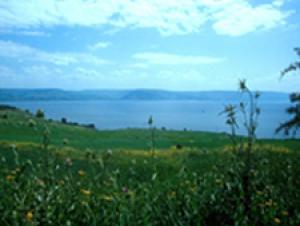Articles Showing 24 of 820

The Main Assembly Hall at Qumran
With the Dead Sea to the east of Qumran in the background, we can see the size of the assembly hall. On the right is the kitchen where the food was prepared. The size of the room and its prominence highlight the importance of this sacred meal to t...

The Making of a City
The environment of the Middle East, including Israel, is harsh and mostly unsuitable for settlement. For a location to be habitable, three conditions were needed:1. Fresh Water - Although rainfall is plentiful in some regions of Israel, most rain ...

The Meaning of the Rock
Throughout church history, there has been discussion and debate on exactly what Jesus meant when he said, 'on this rock I will build my church' (Matt. 16:28). The cliff face in Caesarea Philippi that was used for centuries in idol worship provides...

The Mount of Olives
The Mount of Olives is 2,650 feet above sea level. The ridge is two miles long. Beyond the Mount of Olives is the Judea Wilderness. The Old Testament predicted that the Messiah would come from the east through the wilderness and would enter Jerusa...

The Mudbrick Gate in the Tel of Dan
This gate was filled in 3,500 years ago, during an ancient "urban renewal." You can still see the stone pavement leading to the gate. Note the mud brick arch over the supported entrance. Just inside the entrance are the gate chambers typ...

The New City
This view is from the northwest looking southeast across the New City. Jerusalem expanded to the north in Jesus' time, to the area in the foreground called the New City. The wall in the center is the second wall, and the area inside it is the busi...

The Northern Edge of the Wilderness
This land is at the northern edge of the Israelite wandering. Clearly, the people of Israel could not have survived without God's provision. They had to learn to depend on him. The small shrubs that grow here were called broom trees and frequently...

The Oasis of Jericho
This photograph displays the sharp contrast between the barrenness of the wilderness and the fertility of the oasis of Jericho. The lushness of Sodom and Gomorrah against the desolate plain would have appeared this way to Lot.

The Outer Court of the Temple at Arad
Altar of sacrifice: It measures 4.5 feet high and 7.5 feet square, the same dimensions as the altar of the tabernacle. It is made of unworked stones, just as God commanded. A large stone on top provided a place for the sacrifice to be made. Archae...

The Path to the Cross
DVD-The Path to the Cross - DVD w/ Leader's guide in DVD caseSynopsis:God’s story culminates with the intense devotion of his people in this 11th volume of the Faith Lessons series. Discover how their passionate faith prepares the way for Je...

The People God Uses
There are numerous biblical accounts of those who came from a sinful past, chose a personal relationship with God through Jesus, and went on to become powerful instruments in sharing the message of Jesus. God reveals the depth of his forgiveness b...

The Philistines
The Old Testament frequently mentions the Philistines, a pagan people who clashed with God's children in the Promised Land. The Bible itself provides many interesting facts about Philistine culture, and archaeological discoveries have added to our...

The Pilate Stone
While excavating the theater in 1961, archaeologists discovered this stone, which was being used as a step in a small stairway. When they had uncovered it, they found that it was in secondary use.Originally, it had been the dedication stone for a ...

The Plain of Gennesaret
This aerial view looks north over the fertile plain of Gennesaret. The road follows the route of the biblical Way of the Sea (Matt. 4:12-17). The modern-day Kibbutz Ginnosar is not far from what was Gennesaret in Jesus' time.In the distance along ...

The Promised Land
When the Israelites finally reached the edge of the Promised Land after wandering 40 years in the barren wilderness, they must have been overwhelmed by Canaan's fertility. To North Americans, it does not look particularly lush; but to desert nomad...

The Remains of Susita
This neatly arranged row of marble and basalt columns was part of a basilica church during the period after Jesus' time. The floor of the church was made of colored marble tiles arranged in geometric designs. This church was in Kursi, near Susita....

The Road to Jerusalem
The roads leading to Jerusalem through the Judea Wilderness traverse some barren, desolate, and rugged areas. This path following a wadi is one such trail. Seeing this path can help us understand the parable Jesus told of a man who went down to Je...

The Salt of the Earth
The City of SardisLocated on Mount Tmolus in southern Turkey, the city of Sardis stood at the crossroads of Asia Minor, the most prosperous, powerful, fertile, and pagan province of the entire Roman Empire. First-century Sardis had a unique blend ...

The Sea and the Abyss
The Sea of Galilee is beautiful, but its calm, peaceful setting does not present a complete picture of ancient people's feelings toward it: Many biblical images related to the sea had very negative connotations.Jews were not seafarers; they were d...

The Sea of Galilee
Rabbis of ancient times said, "The Lord has created seven seas, but the Sea of Galilee is his delight." Anyone who sees the Sea of Galilee understands this statement: The blue water, set against a green and brown background of surroundin...

The Seeds of Revolt
The Seeds of RevoltThe Seeds After the Romans began their occupation of Judea in 64 BC, the Jews became divided on how to respond.The religious leaders, particularly the Pharisees, believed the Messiah would come from the Jewish people and make Is...

The Shephelah
Shephelah is a Hebrew word meaning "low" and is usually translated "lowlands" or "foothills." The term refers to a twelve to fifteen-mile wide region in Judea, comprised of foothills that are located between the coast...

The Sleeping Loft
Located on the second floor, this typical loft provided sleeping space for the family. The bed is a wooden frame with rope stretched over it. The mat over the bed provided some additional comfort. In poorer families, people often slept on mats on ...

The Storeroom
This storeroom was where the occupants kept their all-important farming tools. Most families needed to provide their own food. Small gardens, vineyards with grapes and olive trees, and some small livestock provided most of their diet.Hanging on th...


